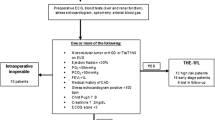Abstract
Background
Despite improvements in the multimodality approach, overall survival of oesophageal cancer (EC) remains very low. Given the rarity of the disease and the lack of large prospective studies, controversy still surrounds the optimal type of surgery and the use of adjuvant and neoadjuvant therapy. Traditionally, the debate concerning the extent of lymphadenectomy is between transhiatal oesophagectomy with 1-field lymphadenectomy (THE-1FL) and transthoracic oesophagectomy with 2-field lymphadenectomy (TTE-2FL). The purpose of this study is to evaluate the effect of optimal patient selection for submission to each procedure in terms of overall survival.
Methods
Patients with EC were prospectively enrolled in a database, and a protocol of individualized surgical treatment of EC (PISTEC) was applied to patients with resectable disease. The PISTEC is based on the patient’s physical status and disease stage, with intent to select the appropriate surgical procedure for each patient.
Results
From 01/2006 to 12/2011, 61 patients with EC were individualized according to the PISTEC, of whom 52.4% were submitted to THE-1FL and 31.1% to TTE-2FL. The 30-day mortality rate was 4.9%. The 5-year overall survival rate was 54.9%, and recurrence was observed in 27.5% of patients. The estimated 5-year overall survival of patients with stages 0, I, II, III and IV was 100%, 100%, 92.9%, 45% and 0%, respectively.
Conclusion
The algorithm proposed by the PISTEC aims at balancing perioperative risks with oncological benefit. When the type of surgery is individualized, the outcomes regarding survival are favourable. This effect could probably be enhanced with the concurrent application of neoadjuvant treatment.
Similar content being viewed by others
References
Gavin AT, Francisci S, Foschi R, et al; EUROCARE-4 Working Group. Oesophageal survival in Europe: A EUROCARE-4 study. Cancer Epidemiol 2012;36:505–12.
Rutegard M, Charonis K, Lu Y, Lagergren P, Lagergren J, Rouvelas I. Population-based esophageal cancer survival after resection without neoadjuvant therapy: An update. Surgery 2012;152:903–10.
Omloo JM, Lagarde SM, Hulscher JB, et al. Extended transthoracic resection compared with limited transhiatal resection for adenocarcinoma of the mid/distal esophagus. Five-year survival of a randomized clinical trial. Ann Surg 2007;246:992–1000.
Theodorou D, Drimousis PG, Larentzakis A, Papalois A, Toutouzas KG, Katsaragakis S. The effects of vasopressors on perfusion of gastric graft after esophagectomy. An experimental study. J Gastrointest Surg 2008;12:1497–501.
Japan Esophageal Society. Japanese Classification of Esophageal Cancer tenth edition: part I. Esophagus 2009;6:1–25.
Strasberg SM, Linehan DC, Hawkins WG. The accordion severity grading system of surgical complications. Ann Surg 2009;250:177–86.
Goldminc M, Maddern G, Le Prise E, et al. Transhiatal approach or thoracotomy: a prospective randomized trial. Br J Surg 1993;80:367–70.
Chu KM, Law SY, Fok M, Wong J. A prospective randomized comparison of transhiatal and transthoracic resection for lower-third esophageal carcinoma. Am J Surg 1997;174:320–4.
Hulscher JB, van Sandick JW, de Boer AG, et al. Extended transthoracic resection compared with limited transhiatal resection for adenocarcinoma of the esophagus. N Engl J Med 2002;347:1662–9.
Orringer MB, Marshall B, Chang AC, Lee J, Pickens A, Lau CL. Two thousand transhiatal esophagectomies changing trends, lessons learned. Ann Surg 2007;246:363–72.
Chang AC, Ji H, Birkmeyer NJ, Orringer MB, Birkmeyer JD. Outcomes after transhiatal and transthoracic esophagectomy for cancer. Ann Thorac Surg 2008;85:424–9.
van Hagen P, Hulshof MC, van Lanschot JJ, et al; CROSS Group. Preoperative chemoradiotherapy for esophageal or junctional cancer. N Engl J Med 2012;366:2074–84.
Lv J, Cao XF, Zhu B, Ji L, Tao L, Wang DD. Long-term efficacy of perioperative chemoradiotherapy on esophageal squamous cell carcinoma. World J Gastroenterol 2010;16:1649–54.
Ando N, Kato H, Igaki H, et al. A randomized trial comparing postoperative adjuvant chemotherapy with cisplatin and 5-fluorouracil versus preoperative chemotherapy for localized advanced squamous cell carcinoma of the thoracic esophagus (JCOG9907). Ann Surg Oncol 2012;19:68–74.
Hulscher JBF, van Lanschot JJ. Individualized surgical treatment of patients with an adenocarcinoma of the distal oesophagus or gastro-oesophageal junction. Dig Surg 2005;22:130–4.
Donohoe CL, O’Farrell NJ, Ravi N, Reynolds JV. Evidencebased selective application of transhiatal esophagectomy in a high-volume esophageal center. World J Surg 2012;36:98–103.
Erasmus JJ, Munden RF. The Role of Integrated Computed Tomography Positron-Emission Tomography in Esophageal Cancer: Staging and Assessment of Therapeutic Response. Semin Radiat Oncol 2006;17:29–37
Wang Z, Chen JQ. Imaging in assessing hepatic and peritoneal metastases of gastric cancer: a systematic review. BMC Gastroenterol 2011;11:19.
Wren SM, Stijns P, Srinivas S. Positron Emission Tomography in the Initial Staging of Esophageal Cancer. Arch Surg 2002;137:1001–7.
Smyth EC, Shah MA. Role of (18F) 2-fluoro-2-deoxyglucose positron emission tomography in upper gastrointestinal malignancies. World J Gastroenterol 2011;17:5059–74.
Akutsu Y, Matsubara H. The significance of lymph node status as a prognostic factor for esophageal cancer. Surg Today 2011;41:1190–5.
Chen YJ, Schultheiss TE, Wong JYC, Kernistine KH. Impact of the number of resected and involved lymph nodes on esophageal cancer survival. Journal of Surgical Oncology 2009;100:127–32.
Altorki NK, Zhou XK, Stiles B, et al. Total number of resected lymph nodes predicts survival in esophageal cancer. Ann Surg 2008;248:221–6.
Peyre CG, Hagen JA, DeMeester SR, et al. The number of lymph nodes removed predicts survival in esophageal cancer: an international study on the impact of extent of surgical resection. Ann Surg 2008;248:549–56.
Greenstein AJ, Litle VR, Swanson SJ, Divino CM, Packer S, Wisnivesky JP. Prognostic significance of the number of lymph node metastases in esophageal cancer. J Am Coll Surg 2008;206:239–46.
Mariette C, Piessen G, Briez N, Triboulet JP. The number of metastatic lymph nodes and the ratio between metastatic and examined lymph nodes are independent prognostic factors in oesophageal cancer regardless of neoadjuvant chemoradiation or lymphadenectomy extent. Ann Surg 2008;247:365–71.
Author information
Authors and Affiliations
Corresponding author
Rights and permissions
About this article
Cite this article
Doulami, G., Triantafyllou, S., Memos, N. et al. Is there room for improvement in oesophageal cancer surgery? Results of a prospective protocol for individualization of surgical treatment. Hellenic J Surg 87, 368–376 (2015). https://doi.org/10.1007/s13126-015-0243-0
Received:
Accepted:
Published:
Issue Date:
DOI: https://doi.org/10.1007/s13126-015-0243-0




